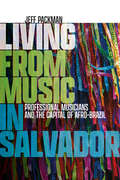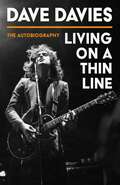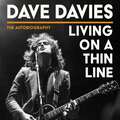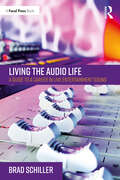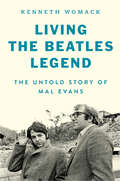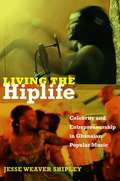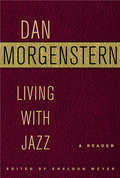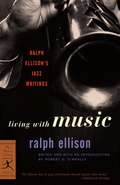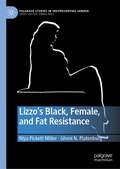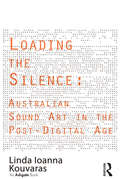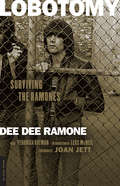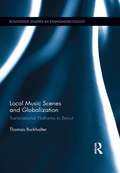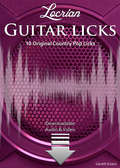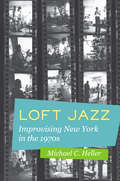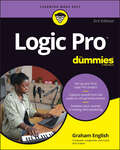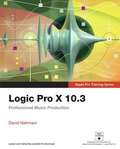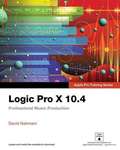- Table View
- List View
Living Proof: An Autobiography
by Hank Williams Jr. Michael BaneAlmost singlehandedly Hank Williams, Sr., changed country and western music into a national mania. When he died in 1953, he became a mythic figure. From the day his famous father died, Hank Junior was pushed to fill his father's shoes. By the time he was seven, he had been tutored by Johnny Cash, Jerry Lee Lewis and Brenda Lee. At the ripe old age of eight, he played his first show, singing his daddy's songs and telling his daddy's stories, and even then it was apparent he had inherited his father's musical genius. His rise to fame was spectacular: at eleven he premiered at the Grand Ole Opry and at fourteen was a hit on the "Ed Sullivan Show." At nineteen Hank Junior was perched atop show business. But success took its toll. The demons of drugs and booze that had destroyed his father began to claim the son. Two marriages failed. Hostile audiences came to watch him forget lyrics or drop his guitar. The pressures were so enormous Hank Junior wanted to die. Then in 1975 Hank's death wish was almost granted when he slid five hundred feet down a mountain in the Rockies, landing head first on a boulder. Awaiting certain death in the snow, his face split apart, Hank had a powerful revelation--he wanted desperately to live, and amazingly he did. With a sense of wonder, Hank takes his survival as a sign he isn't to end up like his father. Now twenty-nine, Hank just released his twenty-fourth album and has a full concert schedule. With his career stronger than ever, this great singer movingly conveys his extraordinary life and his tortured journey to escape from under the dark shadow of his father's ill-fated life.
Living Well with Dementia through Music: A Resource Book for Activities Providers and Care Staff
by Sarah Metcalfe Nigel Marshall Ruth Melhuish Alison Acton Clare Barone Arash Bazrafshan Melanie Burton Evan Dawson Melissa Elliott Maggie Grady Tobias Kaye Nicola Jacobson-Wright Harriet Powell Trish Vella-Burrows Ian SpinkMusic is an essential tool in dementia care. This accessible guide embraces ways in which music can enhance the daily lives of those with dementia. It draws on the expertise of practitioners regularly working in dementia settings, as well as incorporating research on people with dementia, to help anyone, whether or not they have any musical skills or experience, to successfully use music in dementia care.Guiding the reader through accessible activities with singing, percussion, sounding bowls and other musical tools, the book shows how music may can be used from the early to late stages of dementia. This creative outlet can extend to inspire dance, movement, poetry and imagery. The chapters include creative uses of technology, such as tablets and personal playlists.The book also covers general considerations for using music with people living with dementia in institutional settings, including evaluating and recording outcomes.Living Well with Dementia through Music is the perfect go-to guide for music-based activities with people living with dementia.
Living from Music in Salvador: Professional Musicians and the Capital of Afro-Brazil (Music / Culture)
by Jeff PackmanLiving from Music in Salvador is an examination of music as labor, and musicians as laborers, in Salvador da Bahia, an urban state capital widely regarded as Brazil's most African city. Drawing on fieldwork that spans sixteen years, the book explores local musicians' lives and labors as members of a flexible work force in a setting that is culturally rich but economically poor. Often hidden in plain sight, these musician-workers are crucial participants in the economy of a city of nearly three million people that relies heavily on the commodification of Afro-diasporic expressive culture. Performing in clubs and restaurants, during Carnaval parades and festival celebrations, and on concert stages and recordings (at times backing marquee artists), they support themselves and their families and also serve as public representatives of Bahian culture to residents and tourists alike. Yet such audibility and the wages they earn from it are contingent on their ability to navigate complex and often contradictory industry and societal conditions that are profoundly informed by the entrenched legacies of colonization, the African slave trade, and the plantation system.
Living on a Thin Line
by Dave DaviesThe all new, must-read memoir by legendary Kinks guitarist Dave Davies'BOOK OF THE DAY' - Guardian'This powerful tell-all from the Kinks guitarist puts the spotlight on his own bad behaviour, dalliances with the occult and his recovery from a stroke.' - Observer'Heartfelt, hilarious, revealing, insightful and astonishingly candid. Boy, you really got me Dave. I can't wait to read it again.' - Mark Hamill Dave Davies is the co-founder and lead guitarist of epoch-defining band the Kinks, a group with fifty million record sales to their name. In his autobiography, Davies revisits the glory days of the band that spawned so much extraordinary music, and which had such a profound influence on bands from The Clash and Van Halen to Oasis and Blur. Full of tales of the tumultuous times and the ups-and-downs of his relationship with his brother Ray, along with encounters with the likes of John Lennon and Jimi Hendrix, this will be a glorious read for Kinks fans and anyone who wants to read about the heyday of rock 'n' roll.
Living on a Thin Line
by Dave DaviesThe all new, must-read memoir by legendary Kinks guitarist Dave Davies'BOOK OF THE DAY' - Guardian'This powerful tell-all from the Kinks guitarist puts the spotlight on his own bad behaviour, dalliances with the occult and his recovery from a stroke.' - Observer'Heartfelt, hilarious, revealing, insightful and astonishingly candid. Boy, you really got me Dave. I can't wait to read it again.' - Mark Hamill Dave Davies is the co-founder and lead guitarist of epoch-defining band the Kinks, a group with fifty million record sales to their name. In his autobiography, Davies revisits the glory days of the band that spawned so much extraordinary music, and which had such a profound influence on bands from The Clash and Van Halen to Oasis and Blur. Full of tales of the tumultuous times and the ups-and-downs of his relationship with his brother Ray, along with encounters with the likes of John Lennon and Jimi Hendrix, this will be a glorious read for Kinks fans and anyone who wants to read about the heyday of rock 'n' roll.
Living on a Thin Line
by Dave DaviesThe all new, must-read memoir by legendary Kinks guitarist Dave DaviesDave Davies is the co-founder and lead guitarist of epoch-defining band the Kinks, a group with fifty million record sales to their name. In his autobiography, Davies revisits the glory days of the band that spawned so much extraordinary music, and which had such a profound influence on bands from The Clash and Van Halen to Oasis and Blur. Full of tales of the tumultuous times and the ups-and-downs of his relationship with his brother Ray, along with encounters with the likes of John Lennon and Jimi Hendrix, this will be a glorious listen for Kinks fans and anyone who wants to hear about the heyday of rock 'n' roll.(P) 2022 Headline Publishing Group Ltd
Living the Audio Life: A Guide to a Career in Live Entertainment Sound
by Brad SchillerLiving the Audio Life details the aspects and procedures necessary for one to have a successful career in live entertainment sound. Encompassing a wide range of topics, the text clearly guides anyone interested in working in a position within the live entertainment audio field. The guide is broken into clearly defined sections, allowing the reader to easily navigate through various subjects including jobs, career, business, creativity, lifestyle, and travel. Real-world examples and documentation from the author and key industry experts allow the reader to gain insight into the essential practices that are helpful throughout a career. Additional in-depth interviews provide details of careers from industry veterans. Whether considering a career in live entertainment audio or just starting out, readers will find the resources for the key to success in audio. Students, those new to sound, and workers already within their careers can refer to the text as a guide throughout their journeys. With benefits to anyone interested in the audio field, Living the Audio Life is a key navigational resource for success.
Living the Beatles Legend: The Untold Story of Mal Evans
by Kenneth WomackThe first full-length biography of Mal Evans, the Beatles’ beloved friend, confidant, and roadie. Malcolm Evans, the Beatles’ long-time roadie, personal assistant, and devoted friend, was an invaluable member of the band’s inner circle. A towering figure in horn-rimmed glasses, Evans loomed large in the Beatles’ story, contributing at times as a performer and sometime lyricist, while struggling mightily to protect his beloved “boys.” He was there for the whole of the group’s remarkable, unparalleled story: from the Shea Stadium triumph through the creation of the timeless cover art for Sgt. Pepper’s Lonely Hearts Club Band and the famous Let It Be rooftop concert. Leaving a stable job as telecommunications engineer to serve as road manager for this fledgling band, Mal was the odd man out from the start—older, married with children, and without any music business experience. And yet he threw himself headlong into their world, traveling across the globe and making himself indispensable. In the years after the Beatles’ disbandment, Big Mal continued in their employ as each embarked upon solo careers. By 1974, he was determined to make his name as a songwriter and record producer, setting off for a new life in Los Angeles, where he penned his memoirs. But in January 1976, on the verge of sharing his book with the world, Evans’s story came to a tragic end during a domestic standoff with the LAPD.For Beatles devotes, Mal’s life and untimely death have always been shrouded in mystery. For decades, his diaries, manuscripts, and vast collection of memorabilia was missing, seemingly lost forever…until now. Working with full access to Mal’s unpublished archives and having conducted hundreds of new interviews, Beatles’ scholar and author Kenneth Womack affords readers with a full telling of Mal’s unknown story at the heart of the Beatles’ legend. Lavishly illustrated with unseen photos and ephemera from Mal’s archives, Living the Beatles’ Legend: The Untold Story of Mal Evans is the missing puzzle piece in the Fab Four’s incredible story.
Living the Dream: Building a Sustainable Career in the Performing Arts
by Kirstin Chávez Johnathon PapeLiving the Dream: Building a Sustainable Career in the Performing Arts offers an accessible guide to understanding one’s arts career as a business. This essential companion to the inner workings of the arts world begins with defining the dream, including how to conceive mission statements, branding and business plans. Part II covers sharing the dream with others through social media, networking, and working with agents or artist managers. Part III offers an overview of the financial aspect, including budgets, taxes, and managing risks. Part IV concludes by discussing the realities of an arts career, including work/life balance, preparing for the future, and managing mental health. This practical and insightful overview is a must‑have companion for aspiring and early career professionals in the performing arts, as well as students on a range of arts courses, including Music Business, Entrepreneurship, and Career Skills classes.
Living the Hiplife: Celebrity and Entrepreneurship in Ghanaian Popular Music
by Shipley Jesse WeaverHiplife is a popular music genre in Ghana that mixes hip-hop beatmaking and rap with highlife music, proverbial speech, and Akan storytelling. In the 1990s, young Ghanaian musicians were drawn to hip-hop's dual ethos of black masculine empowerment and capitalist success. They made their underground sound mainstream by infusing carefree bravado with traditional respectful oratory and familiar Ghanaian rhythms. Living the Hiplife is an ethnographic account of hiplife in Ghana and its diaspora, based on extensive research among artists and audiences in Accra, Ghana's capital city; New York; and London. Jesse Weaver Shipley examines the production, consumption, and circulation of hiplife music, culture, and fashion in relation to broader cultural and political shifts in neoliberalizing Ghana. Shipley shows how young hiplife musicians produce and transform different kinds of value--aesthetic, moral, linguistic, economic--using music to gain social status and wealth, and to become respectable public figures. In this entrepreneurial age, youth use celebrity as a form of currency, aligning music-making with self-making and aesthetic pleasure with business success. Registering both the globalization of electronic, digital media and the changing nature of African diasporic relations to Africa, hiplife links collective Pan-Africanist visions with individualist aspiration, highlighting the potential and limits of social mobility for African youth. The author has also directed a film entitled Living the Hiplife and with two DJs produced mixtapes that feature the music in the book available for free download.
Living with Jazz
by Dan MorgensternThis volume presents selected writings by jazz historian and critic Dan Morgenstern. It opens with his reminiscences of a childhood spent in front of the phonograph. The following section features pieces devoted to the music of Louis Armstrong and Duke Ellington. The rest of the volume contains artist profiles, liner notes, record reviews, and performance critiques that offer insight into the work of a broad spectrum of performers. Morgenstern is director of the Institute of Jazz at Rutgers University. Annotation ©2004 Book News, Inc. , Portland, OR (booknews. com)
Living with Music: Ralph Ellison's Jazz Writings
by Ralph EllisonBefore Ralph Ellison became one of America’s greatest writers, he was a musician and a student of jazz, writing widely on his favorite music for more than fifty years. Now, jazz authority Robert O’Meally has collected the very best of Ellison’s inspired, exuberant jazz writings in this unique anthology.
Lizzo’s Black, Female, and Fat Resistance (Palgrave Studies in (Re)Presenting Gender)
by Niya Pickett Miller Gheni N. PlatenburgCelebrated musician and entertainer Lizzo wowed audiences and left many “feeling good as hell.” Notwithstanding her collective—fat, Black female— identity she catapulted into mainstream success while redefining the social script for body size, race, and gender. This book explores a tale of two narratives: Lizzo’s self-curated, fat-positive identity and the media’s reaction to an unabashedly proud fat, Black woman. This critical analysis examines how Lizzo challenges fatphobia and reconstitutes fat stigmatization into self-empowerment through her strategic use of hyper-embodiment via social media, and the rhetorical distinctions between Lizzo’s self-curated narrative via social media and those offered about her in print media. In part, Lizzo’s bodily flaunting is argued as a significant rhetorical act that emancipates her identity of fatness and reframes the negative tropes of (fat) Black women typically curated in American culture.
Loaded: The Life (and Afterlife) of The Velvet Underground
by Dylan JonesRebellion always starts somewhere, and in the music world of the transgressive teen whether it be the 1960s of the 2020s, The Velvet Underground represent ground zero. Crystallizing the idea of the bohemian, urban, narcissistic art school gang, around a psychedelic rock and roll band - a stylistic idea that evolved in the rarefied environs of Andy Warhol's Factory - The Velvets were the first major American rock group with a mixed gender line-up; they never smiled in photographs, wore sunglasses indoors, and in the process invented the archetype. They were avant-garde nihilists, writing about drug abuse, prostitution, paranoia, and sado-masochistic sex at a time when the rest of the world was singing about peace and love. Dylan Jones' definitive oral history of The Velvet Underground draws on contributions from remaining members, contemporaneous musicians, critics, film-makers, and the generation of artists who emerged in their wake, to celebrate not only their impact but their legacy, which burns brighter than ever into the 21st century.
Loaded: The Life (and Afterlife) of the Velvet Underground
by Dylan JonesDrawing on contributions from remaining members, contemporaneous musicians, critics, filmmakers, and the generation of artists who emerged in their wake, this "monumental origin story" celebrates the legacy of the Velvet Underground, which burns brighter than ever in the 21st century (New York Times bestselling author Bob Spitz). A "Must Read" by Nylon and BookRiot Rebellion always starts somewhere, and in the music world of the transgressive teen—whether it be the 1960s or the 2020s—the Velvet Underground represents ground zero. Crystallizing the idea of the bohemian, urban, narcissistic art school gang around a psychedelic rock and roll band—a stylistic idea that evolved in the rarefied environs of Andy Warhol&’s Factory—the Velvets were the first major American rock group with a mixed gender line-up. They never smiled in photographs, wore sunglasses indoors, and invented the archetype that would be copied by everyone from Sid Vicious to Bobby Gillespie. They were avant-garde nihilists, writing about drug abuse, prostitution, paranoia, and sado-masochistic sex at a time when the rest of the world was singing about peace and love. In that sense they invented punk and then some. It could even be argued that they invented modern New York. Drawing on interviews and material relating to all major players, from Lou Reed, John Cale, Mo Tucker, Andy Warhol, Jon Savage, Nico, David Bowie, Mary Harron, and many more, award-winning journalist Dylan Jones breaks down the band&’s whirlwind of subversion and, in a narrative rich in drama and detail, proves why the Velvets remain the original kings and queens of edge.
Loading the Silence: Australian Sound Art In The Post-digital Age
by Linda Ioanna KouvarasThe experimentalist phenomenon of 'noise' as constituting 'art' in much twentieth-century music (paradoxically) reached its zenith in Cage’s (’silent’ piece) 4’33 . But much post-1970s musical endeavour with an experimentalist telos, collectively known as 'sound art', has displayed a postmodern need to ’load’ modernism’s ’degree zero’. After contextualizing experimentalism from its inception in the early twentieth century, Dr Linda Kouvaras’s Loading the Silence: Australian Sound Art in the Post-Digital Age explores the ways in which selected sound art works demonstrate creatively how sound is embedded within local, national, gendered and historical environments. Taking Australian music as its primary - but not sole - focus, the book not only covers discussions of technological advancement, but also engages with aesthetic standpoints, through numerous interviews, theoretical developments, analysis and cultural milieux for a contemporary Australian, and wider postmodern, context. Developing new methodologies for synergies between musicology and cultural studies, the book uncovers a new post-postmodern aesthetic trajectory, which Kouvaras locates as developing over the past two decades - the altermodern. Australian sound art is here put firmly on the map of international debates about contemporary music, providing a standard reference and valuable resource for practitioners in the artform, music critics, scholars and educators.
Lobotomy: Surviving The Ramones
by Legs Mcneil Dee Dee Ramone Veronica KofmanLobotomy is a lurid and unlikely temperance tract from the underbelly of rock 'n' roll. Taking readers on a wild rollercoaster ride from his crazy childhood in Berlin and Munich to his lonely methadone-soaked stay at a cheap hotel in Earl's Court and newfound peace on the straight and narrow, Dee Dee Ramone catapults readers into the raw world of sex, addiction, and two-minute songs. It isn't pretty. With the velocity of a Ramones song, Lobotomy rockets from nights at CBGB's to the breakup of the Ramones' happy family with an unrelenting backbeat of hate and squalor: his girlfriend ODs; drug buddy Johnny Thunders steals his ode to heroin, "Chinese Rock"; Sid Vicious shoots up using toilet water; and a pistol-wielding Phil Spector holds the band hostage in Beverly Hills. Hey! Ho! Let's go!
Local Music Scenes and Globalization: Transnational Platforms in Beirut (Routledge Studies in Ethnomusicology)
by Thomas BurkhalterThis book offers the first in-depth study of experimental and popular music scenes in Beirut, looking at musicians working towards a new understanding of musical creativity and music culture in a country that is dominated by mass-mediated pop music, and propaganda. Burkhalter studies the generation of musicians born at the beginning of the Civil War in the Lebanese capital, an urban and cosmopolitan center with a long tradition of cultural activities and exchanges with the Arab world, Europe, the US, and the former Soviet Union. These Lebanese rappers, rockers, death-metal, jazz, and electro-acoustic musicians and free improvisers choose local and transnational forms to express their connection to the broader musical, cultural, social, and political environment. Burkhalter explores how these musicians organize their own small concerts for ‘insider’ audiences, set up music labels, and network with like-minded musicians in Europe, the US, and the Arab world. Several key tracks are analyzed with methods from ethnomusicology, and popular music studies, and contextualized through interviews with the musicians. Discussing key references from belly dance culture (1960s), psychedelic rock in Beirut (1970s), the noises of the Lebanese Civil war (1975-1990), and transnational Pop-Avant-Gardes and World Music 2.0 networks, this book contributes to the study of localization and globalization processes in music in an increasingly digitalized and transnational world. At the core, this music from Beirut challenges "ethnocentric" perceptions of "locality" in music. It attacks both "Orientalist" readings of the Arab world, the Middle East, and Lebanon, and the focus on musical "difference" in Euro-American music and culture markets. On theoretical grounds, this music is a small, but passionate attempt to re-shape the world into a place where "modernity" is not "euro-modernity" or "euro-american modernity," but where possible new configurations of modernity exist next to each other.
Loco por Madonna. La Reina del Pop
by Francisco Rodríguez del Río Francesco Falconi#Rebel2016 Edition - actualización de abril de 2016: ¡Loco por Madonna se convierte en un ePub en vivo! La biografía de Madonna será actualizada una vez al año. En treinta años de carrera, entre giras mundiales, sencillos exitosos, películas y libros, Madonna no ha pasado jamás inobservada. Desde el lejano 1982, ha capturado la atención de miles de muchachitas que imitaban su imagen provocadora, entonaban sus canciones y la transformaban poco a poco en icono del feminismo y de la libertad sexual y de expresión. Madonna, contra todo pronóstico, ha atravesado las décadas viviendo en total simbiosis con nuestra sociedad, cabalgando modas mediáticas, a menudo dictándolas ella misma. Así, mientras las estrellas de los años 80 se eclipsaban, la estrella de "Like a Virgen" se establecía continuamente en lo más alto de las listas de todo el mundo. Una artista con tantas facetas, un icono camaleónico por excelencia, que se ha reinventado a sí misma como cantante, actriz, bailarina, directora, hábil empresaria, abeja reina de la música pop y astuta provocadora; pero también como madre y como mujer de gran compromiso humanitario y social (fundadora de la Raising Malawi Foundation). En Locos por Madonna, se recorre toda su larga carrera, desde sus comienzos hasta nuestros días, en un juego continuo de luces y sombras. La carrera que la ha coronado como reina indiscutible del pop mundial (con más de 200 millones de discos vendidos). Una biografía completa y apasionante con un apéndice dedicado al MadonnaTribe, uno de los puntos de referencia más importantes del fandom italiano y europeo.
Locrian Guitar Licks: 10 Original Country Pop Licks with Audio & Video (Modal Guitar Licks #7)
by Gareth Evans10 original country pop guitar licks from the Locrian mode in tablature and notation for the progressing guitarist at intermediate level and above. >> 55 bars of music over 10 licks (average lick length 5.5 bars) >> Video at full speed & Audio at full & half speed (Downloadable) >> Backing tracks at full and slower practise speeds (Downloadable) >> Scale diagrams with theory and technique tips for each lick >> Guitar tablature has picking directions & fretting finger guide numbers Please Note: This eBook has written music and is not suitable for smaller screens.
Loft Jazz: Improvising New York in the 1970s
by Michael C. HellerThe New York loft jazz scene of the 1970s was a pivotal period for uncompromising, artist-produced work. Faced with a flagging jazz economy, a group of young avant-garde improvisers chose to eschew the commercial sphere and develop alternative venues in the abandoned factories and warehouses of Lower Manhattan. Loft Jazz provides the first book-length study of this period, tracing its history amid a series of overlapping discourses surrounding collectivism, urban renewal, experimentalist aesthetics, underground archives, and the radical politics of self-determination.
Logan's Song
by Tracy Stuffle Libbi StuffleThis book discusses the loss of Libbi's son Logan. She talks about how she got through the miscarriage and how God helped her cope with the loss of her still-born child. Also gives tips for helping family/friends who are experiencing this type of loss.
Logic Pro For Dummies
by Graham EnglishThis one-stop source for Logic Pro insight helps you spend more time creating music Every minute you spend trying to figure out how to set up a new track or build a drum loop is a minute you don’t spend creating and recording your music. This guide to the recording software favored by Mac users helps you bypass the time needed to search for tech answers and spend more time capturing sounds. Discover the full recording power of Logic Pro, starting with launching a project and recording your audio. Explore the built-in digital instruments and beat makers, augment your recording power with plug-ins, and finalize your song by editing, adding effects, mixing, mastering, and sharing. The final step is music stardom! Learn your way around the Logic Pro interface and understand the workflow Set up your project and add tracks and regions Record acoustic audio or conduct your orchestra of MIDI instruments Edit, mix, automate, export, and feel proud of your audio filesFor beginning music creators and producers, this Dummies guide makes it simple to get started with Logic Pro.
Logic Pro X 10. 3 - Apple Pro Training Series: Professional Music Production (Apple Pro Training )
by David Nahmani<P>The Apple-Certified Way to Learn <P>Record, arrange, mix, produce, and polish your music with this bestselling, Apple-certified guide to Logic Pro X 10.3. Veteran producer and composer David Nahmani uses step-by-step, project-based instructions and straightforward explanations to teach everything from basic music creation to sophisticated production techniques. Using the book’s downloadable lesson files and Logic Pro X, you’ll begin making music in the first lesson. <P>From there, you’ll learn to record audio and MIDI, create and edit sequences, and master mixing and automation techniques such as submixing with Track Stacks or the practical uses of true stereo panning. You will create both acoustic and electronic virtual drum performances using Drummer tracks with Drum Kit Designer and Drum Machine Designer. You’ll use Logic Pro X MIDI plug-ins and Smart Controls to control software synthesizers from a MIDI controller or an iPad. Flex Time will allow you to precisely edit the timing of notes inside an audio recording, and you’ll explore Flex Pitch to correct the pitch of a vocal recording. Finally, you’ll mix, automate, and master the song, using plug-ins to process only selected sections or entire tracks, giving your audio creations the final polish needed to achieve a professional sound. <P>Downloadable lesson and media files allow you to perform the hands-on exercises. <br>Focused lessons take you step by step through practical, real-world tasks. <br>Ample illustrations help you master techniques fast. <br>Lesson goals and time estimates help you plan your time. <br>Chapter review questions help you prepare for the Logic Pro X 10.3 certification exam. <P>The Apple Pro Training Series is both a self-paced learning tool and the official curriculum of the Apple Training and Certification program. Upon completing the course material in this guide, you can become Apple Certified by passing the Logic Pro X 10.3 certification exam at an Apple Authorized Training Provider. To find an Apple Authorized Training Provider near you, please visit training.apple.com. <P>Also in the Apple Pro Training Series: <br>Final Cut Pro X 10.3 <br>Pages, Numbers, and Keynote <br>macOS Support Essentials
Logic Pro X 10. 4 - Apple Pro Training Series: Professional Music Production (Apple Pro Training)
by David NahmaniRecord, arrange, mix, produce, and polish your audio files with this best-selling, Apple-certified guide to Logic Pro X 10.4. Veteran producer and composer David Nahmani uses step-bystep, project-based instructions and straightforward explanations to teach everything from basic music creation to sophisticated production techniques. Using the book’s downloadable lesson files and Logic Pro X, you’ll begin making music in the first lesson. From there, learn to record audio and MIDI data, create and edit sequences, and master mixing and automation techniques such as submixing with track stacks. Create both acoustic and electronic virtual drum performances using Drummer tracks with Drum Kit Designer and Drum Machine Designer. Use Logic Pro X MIDI FX and Smart Controls to control software synthesizers from a MIDI controller or an iPad. Harness the power of Smart Tempo to make sure all recordings, imported audio files, and samples play in time. Flex Time allows you to precisely edit the timing of notes inside an audio recording, and you’ll explore Flex Pitch to correct the pitch of a vocal recording. Finally, you mix, automate, and master the song, using plug-ins to process only selected sections or entire tracks, giving your audio creations the final polish needed to achieve a professional sound. Downloadable lesson and media files allow you to perform the hands-on exercises. Focused lessons take you step by step through practical, real-world tasks. Accessible writing style puts an expert instructor at your side Ample illustrations help you master techniques fast. Lesson goals and time estimates help you plan your time. Chapter review questions summarize what you’ve learned and help you prepare for the Apple certification exam.


